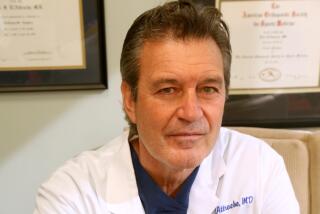Bone Surgery: Up Close and Personal
- Share via
In my seven-year career as a newspaper photographer, I’ve had the opportunity to see many things from better than front row seats. I’ve been on the sidelines for Super Bowls, World Series and the Olympics. I’ve photographed the Academy Awards and Space Shuttle landings. All of these events interested me, but some of my most exciting moments came in the relative quiet of operating rooms where I’ve photographed orthopedic joint replacement surgeries.
After having surgery on my own shoulder 18 months ago--not joint replacement but a different type--I decided that I wanted to see what went on in the operating room unanesthetized. My orthopedic surgeon, Dr. T. Michael Lain of Santa Monica, suggested that it would be interesting for me to see and photograph a replacement operation for an arthritic hip joint.
At first, I wondered what I had gotten myself into, but after the surgeons began to work I was mesmerized by their skills. I have since seen a knee and a shoulder--also eaten away by arthritis--replaced with artificial joints.
After seeing up close a bare joint that has been attacked by arthritis, I can finally understand why the disease is so painful. Just imagine the end of a simple chicken bone with the smooth white covering at the end of the bone. When arthritis attacks, the smooth white cartilage covering becomes ragged and the bone looks more and more like that of a chicken bone that has been gnawed on.
The hip is a ball-and-socket joint. The shoulder joint is similar to the hip though the socket is much shallower. The knee is a hinge-type joint. When arthritis attacks the joint, the cartilage covering each end of the bone starts to wear. And with the knee, the ends of the bone and also the underside of the kneecap are affected. As the cartilage becomes diseased because of the arthritic condition, the smooth and gliding character of the joint is altered. Stress eventually builds causing an increased breakdown of the cartilage under the areas of highest pressure. Eventually bone rides against bone, hence the painful sensations.
When the pains are severe enough, the arthritis sufferer may become a candidate for joint replacement surgery, which is done in an effort to make the joint function as close to the normal anatomy as mechanically possible. The replacement prostheses are made of a hard plastic and various metal alloys with low friction.
The hip surgery, which took about two hours, was performed in a laminar air flow operating room at St. John’s Hospital and Health Center in Santa Monica. The air directly around the surgical field flows in one direction. It then exits and is sterilized by filters before recycling into the operating room. The surgeon and surgical nurse work in what are called and look like “space suits.” Instead of masks, the doctors wear plastic bubbles on their head gear with attached breathing apparatus that channels their breath away from the surgical field to keep the area germ-free. This type of room is often used for hip and knee joint implant surgery because the body area exposed is large and open for a long period of time.
I conveniently had to clean my camera gear as the initial incision was being made for the hip surgery and therefore I didn’t have to watch. Sooner or later I knew I would have to begin to work and decided it was time to open my eyes. Somehow, by looking at the surgery through the security of my camera, I was able to observe without it bothering my senses.
I was a little surprised at the large size of the incision, but the trade-off in mobility is usually worth the almost footlong scar that is left. I was fascinated as the surgeons worked through the muscle and tissue to get to the joint itself. At times it became a little noisy as the surgeons used tools that included the medical equivalent of drills with many different types of bits, water picks, hammers, pliers and chisels. Some of the surgical appliances are run by air pumps, using the same principle as devices commonly seen in gas stations for removal of lug nuts on car wheels.
Fit in Artificial Pieces
Once the diseased part of the joint is cut away, the surgeons begin to fit the artificial pieces.
Thickness and size of the individual joint and amount of bone loss determine the size of the prosthesis. The surgeons try several sizes of prostheses and move the limb in many directions to be sure of proper function. Once the pieces have been set into place with a surgical quick-drying cement, the surgeons then hold the prosthesis into place, applying direct pressure for about 10-15 minutes. One time, as he was waiting for the cement to dry, Lain looked up and matter of factly asked what it was like to shoot the World Series.
After all is set, they close the incision layers, sewing the muscles back together underneath and later stitching the skin.
Shoulder replacement surgery is done in a similar fashion as the hip but with variations determined by its own special anatomy. Although it is a newer surgery than the hip and knee operations, shoulder replacement surgery is being performed with more frequency today. The shoulder surgery I saw, which took about 2 1/2 hours, was performed on an elderly woman with a long history of arthritis. She had limited range of motion, which prevented her from raising her arm above her head or touching her hand to her mouth.
The replacement surgery was performed in February by Dr. Lain. Even I, who has never been trained to read an X-ray, could see easily how the joint had been affected by the arthritis. Recently, I saw the woman in the doctor’s physical therapy office and she was able to raise her arm above her head and in other directions, which were too painful to do before.
The main problem with these types of surgeries, I was told, is the potential of the implanted joints loosening. Therefore, joint replacement is done with great care and caution in younger age groups.
These operations are not only a surgical process but a package that combines surgery with physical therapy rehabilitation.
Physical therapy can be painful at first while mobility is being restored. When I was going through the physical therapy, there were times I never thought I would make it through my sessions, which lasted 45 minutes to an hour. My range of motion was so limited at first that I never thought I would have full use of my shoulder. But as times goes on and normal movement is restored through the hard work of both the patient and physical therapist the pain is soon forgotten.
More to Read
Go beyond the scoreboard
Get the latest on L.A.'s teams in the daily Sports Report newsletter.
You may occasionally receive promotional content from the Los Angeles Times.









